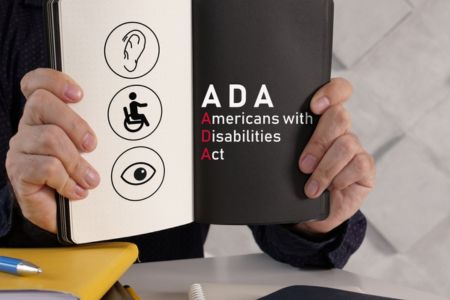As a enterprise proprietor, it’s possible you’ll pay attention to ADA compliance and its significance for bodily accessibility. Nonetheless, many might not be conscious of the influence or threat to their enterprise if their web site is just not ADA-compliant. In recent times, ADA web site compliance lawsuits have surged, and companies are more and more sued for not having accessible web sites. On this article, we’ll dive into the world of ADA web site compliance lawsuits, focus on notable circumstances, and supply suggestions that will help you shield your online business.
ADA Web site Compliance Lawsuits: Defending Your Enterprise

Web site accessibility is a crucial difficulty that impacts tens of millions of individuals with disabilities worldwide. The Individuals with Disabilities Act (ADA) requires companies to make sure that their web sites are accessible to folks with disabilities, similar to they do for his or her bodily premises. This implies companies should make their web sites appropriate utilizing assistive applied sciences and different textual content for pictures and movies.
The ADA has three titles. Title III requires companies that present providers to the general public to make sure accessibility for folks with disabilities and applies to companies reminiscent of eating places, inns, retail shops, and web sites. In case your web site is just not ADA-compliant, you could possibly be vulnerable to an ADA lawsuit.
ADA Title III: What You Must Know
Title III of the Individuals with Disabilities Act (ADA) establishes rules that forbid discrimination in opposition to people with disabilities in venues categorised as locations of public lodging. The Division of Justice (DOJ) issued regulations stating that web sites should be accessible to folks with disabilities in 2010.
In 2018, the DOJ withdrew these regulations, however this doesn’t imply companies are now not required to adjust to the ADA. As an alternative, the DOJ issued an announcement saying that the ADA applies to web sites and that companies ought to observe the Web Content Accessibility Guidelines (WCAG) 2.1, developed by the World Wide Web Consortium (W3C).
The WCAG offers pointers on tips on how to make web sites accessible, and there are three levels of compliance: A, AA, and AAA. Essentially the most generally cited stage is AA, thought-about the usual for ADA compliance. Companies want to ensure that their web site is accessible, practical, understandable, and resilient for all customers, encompassing people with disabilities, so as to adhere to regulatory requirements./p>
ADA Lawsuit Settlements
ADA web site compliance lawsuits have surged in recent times, and companies have paid tens of millions of {dollars} in settlements. In 2022 alone, 3,255 ADA web site accessibility lawsuits had been filed in federal courtroom.
The typical settlement quantity for an ADA web site accessibility lawsuit is between $5,000 and $20,000. Nonetheless, relying on the severity of the violation and the variety of violations, settlements can vary from a couple of thousand {dollars} to tens of millions of {dollars}.
Notable circumstances embrace Beyoncé’s Parkwood Leisure, which was sued for having a web site inaccessible to visually impaired customers. The lawsuit was settled for an undisclosed quantity, however it’s believed to be within the tens of millions.
One other notable case is Domino’s Pizza, which was sued for making its web site and app inaccessible to folks with disabilities. The case went to the Supreme Court docket, and in October 2019, the Court docket declined to listen to it, leaving in place a ruling that allowed the case to proceed in federal courtroom. The case is ongoing however is believed to be one of the crucial important ADA web site accessibility circumstances so far.
Examples of ADA Web site Compliance Violations
Listed below are some examples of ADA compliance violations discovered on web sites. By recognizing these violations, web site house owners and builders can take the required steps to deal with them and make their web sites extra accessible to people with disabilities.
- Lack of Different Textual content for Pictures: Web sites that don’t present different textual content descriptions for pictures could violate ADA compliance pointers. Different textual content permits customers with visible impairments to know a picture’s content material by assistive expertise.
- Inaccessible Varieties: Varieties on a web site could also be inaccessible in the event that they can’t be accomplished utilizing keyboard-only navigation, lack correct labeling or directions, or are incompatible with display readers.
- Insufficient Coloration Distinction:
Web sites that lack enough shade distinction between textual content and background may pose challenges for people with visible impairments, hindering their means to learn and comprehend the content material. ADA pointers advocate a minimal color contrast ratio of 4.5:1 for normal textual content. - Inaccessible Video and Audio Content material: Movies and audio content material that don’t embrace captions or transcripts could violate ADA compliance pointers. Captions or transcripts enable people with listening to impairments to know the web site’s audio content material.
- Lack of Keyboard Navigation: Web sites that can not be navigated utilizing a keyboard alone could violate ADA compliance pointers. Keyboard-only navigation is important for people who can’t use a mouse, together with these with mobility or visible impairments.
You will need to word that ADA compliance pointers are frequently evolving, and web sites ought to repeatedly replace their design and content material to make sure person accessibility.
What Are the Probabilities of Successful an ADA Web site Compliance Lawsuit?

The end result of an ADA web site compliance lawsuit relies on a number of components, together with the case’s particular particulars, the proof introduced, and the courtroom’s interpretation of the regulation. Nonetheless, it’s important to notice that the ADA affords authorized safeguards for people with disabilities and requires companies and organizations to make affordable lodging to make sure accessibility. Chances are you’ll face authorized motion and penalties do you have to fail to adjust to ADA pointers. Due to this fact, web site house owners and builders ought to prioritize accessibility and take steps to make sure their web sites adjust to ADA pointers to scale back the danger of lawsuits and promote equal entry for all people.
Prime Firms Sued for Web site Accessibility
Web site accessibility lawsuits have develop into more and more frequent in recent times, with visually impaired people and incapacity rights teams taking authorized motion in opposition to firms whose web sites should not accessible to folks with disabilities. Here’s a detailed dialogue of the ADA web site compliance lawsuits in opposition to every of the highest 10 firms listed:
- Beyoncé’s Parkwood Leisure: In January 2019, a class-action lawsuit was filed against Parkwood Entertainment, the corporate owned by pop star Beyoncé, alleging that the corporate’s web site was not accessible to visually impaired customers. The lawsuit claimed that the web site violated the Individuals with Disabilities Act (ADA) and the California Unruh Civil Rights Act by failing to offer different textual content for pictures, hyperlink headings, and different options that may allow visually impaired customers to navigate the positioning. The settlement quantity is undisclosed however is believed to be within the tens of millions.
- Domino’s Pizza: In 2016, a blind man named Guillermo Robles filed a lawsuit against Domino’s Pizza, alleging that the corporate’s web site and cell app weren’t accessible to folks with disabilities. The lawsuit claimed that the web site and app violated the ADA by failing to offer display reader software program that may enable blind and visually impaired customers to entry the positioning’s content material. The case went to the Supreme Court docket, which declined to listen to Domino’s enchantment, permitting the case to proceed. The settlement quantity is ongoing.
- Harvard and MIT: The Nationwide Affiliation of the Deaf filed a lawsuit against Harvard and MIT in 2015, alleging that the colleges’ on-line programs didn’t present enough closed captioning for deaf and hard-of-hearing college students. The lawsuit claimed that the colleges’ failure to offer closed captioning violated the ADA and the Rehabilitation Act. The settlement quantity was $750,000.
- Netflix: The Nationwide Affiliation of the Deaf filed a lawsuit against Netflix in 2012, alleging that the streaming service didn’t present closed captioning for a few of its content material, violating the ADA. The lawsuit was settled in 2013, with Netflix agreeing to caption all its content material by 2014. The settlement quantity was $755,000.
- Goal: The Nationwide Federation of the Blind filed a lawsuit against Target in 2006, alleging that the corporate’s web site and app weren’t accessible to folks with disabilities. The lawsuit claimed that the positioning violated the ADA by failing to offer different textual content for pictures, hyperlink headings, and different options that may allow visually impaired customers to navigate the positioning. In 2008, the case was resolved, with Goal consenting to boost its web site’s accessibility for people with disabilities. The settlement quantity was $6 million.
- H&R Block: In 2013, the Nationwide Federation of the Blind filed a lawsuit in opposition to H&R Block, alleging that the corporate’s web site and app weren’t accessible to folks with disabilities. The lawsuit claimed that the positioning violated the ADA by failing to offer different textual content for pictures, hyperlink headings, and different options that may allow visually impaired customers to navigate the positioning. The case was settled in 2017, with H&R Block agreeing to make its website and app accessible to folks with disabilities. The settlement quantity was $1.2 million.
- 5 Guys Burgers and Fries: In 2017, a blind individual named Marett Lucia filed a lawsuit against Five Guys Burgers and Fries, alleging that the corporate’s web site was inaccessible to visually impaired customers. The lawsuit claimed that the positioning violated the ADA by failing to offer different textual content for pictures, hyperlink headings, and different options that may allow visually impaired customers to navigate the positioning. The settlement quantity is just not public.
- Winn-Dixie: In 2016, a blind man named Juan Carlos Gil filed a lawsuit in opposition to Winn-Dixie, alleging that the corporate’s web site was not accessible to visually impaired customers. The lawsuit claimed that the positioning violated the ADA by failing to offer different textual content for pictures, hyperlink headings, and different options that may allow visually impaired customers to navigate the positioning. The case went to trial in 2017, and the courtroom dominated in favor of Gil, awarding him $6 million in damages. The courtroom additionally ordered Winn-Dixie to make its website accessible to folks with disabilities.
As you’ll be able to see, lawsuits regarding web site accessibility are more and more frequent, and firms neglecting to make sure their web sites accommodate people with disabilities face the prospect of authorized repercussions. The settlements for these circumstances vary from lots of of hundreds of {dollars} to tens of millions, and firms should prioritize web site accessibility to keep away from such lawsuits.
Learn how to Keep away from an ADA Web site Accessibility Lawsuit
Now that the dangers and potential penalties of not having an accessible web site, it’s possible you’ll surprise tips on how to keep away from an ADA lawsuit. Listed below are some suggestions that will help you shield your online business:
Tricks to Keep away from a Lawsuit
- Conduct an ADA web site compliance audit: An ADA web site compliance audit can assist determine accessibility points in your web site and supply suggestions to deal with them.
- Comply with the WCAG pointers: Adhere to the WCAG pointers to ensure that your web site accommodates the wants of people with disabilities, guaranteeing full accessibility.
- Practice your employees: Educate your staff concerning the significance of web site accessibility and instruct them on the strategies for growing content material that’s accessible to all customers.
- Monitor your web site: Usually monitor your web site to make sure it stays accessible.
- Have an accessibility assertion: Having an accessibility assertion in your web site demonstrates your dedication to accessibility and can assist cut back the danger of an ADA lawsuit.

Get Skilled Help
If you’re not sure about your web site’s accessibility, it’s best to hunt skilled help. An internet growth firm that gives ADA web site compliance audits and remediation providers can assist guarantee your web site is accessible and supply ongoing monitoring to make sure continued compliance.
Finally, ADA compliance isn’t just about bodily accessibility. Your web site should even be accessible to folks with disabilities. Failure to adjust to ADA web site accessibility pointers can lead to pricey lawsuits and hurt your online business’s repute. By following the WCAG pointers and conducting common accessibility audits, you’ll be able to assist shield your online business from ADA web site compliance lawsuits. Moreover, working with knowledgeable internet growth firm can guarantee your web site stays accessible and compliant. Bear in mind, accessibility is a authorized requirement and the proper factor to do.
If you’re involved that your web site might not be ADA-compliant or have questions on guaranteeing compliance, contact Oyova to schedule a session about ADA compliance audits and remediation. Our workforce of consultants can focus on your choices and work with you to get your web site ADA-compliant. Don’t wait till it’s too late; take motion now to guard your online business and guarantee everybody has equal entry to your web site.




